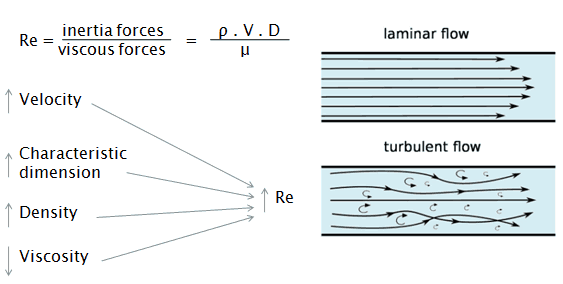Reynolds Number
The Reynolds number represents the ratio of inertial forces to viscous forces and is a convenient parameter for predicting if a flow condition will be laminar or turbulent. It is defined as a characteristic length multiplied by a characteristic velocity and divided by the kinematic viscosity.
It can be interpreted that when the viscous forces are dominant (slow flow, low Re), they are sufficient enough to keep all the fluid particles in line, then the flow is laminar. Even very low Re indicates viscous creeping motion, where inertia effects are negligible. When the inertial forces dominate the viscous forces (when the fluid is flowing faster and Re is larger), the flow is turbulent. The transition from laminar to turbulent flow depends on the surface geometry, surface roughness, free-stream velocity, surface temperature, and fluid type, among other things.
It must be noted the Reynolds number is one of the characteristic numbers (standardized in ISO 80000-11:2019), which can be used to compare a real situation (e.g., airflow around an airfoil and water flow in a pipe) with a small-scale model.
The Reynolds number is defined as:

where:
V is the flow velocity,
D is a characteristic linear dimension (traveled length of the fluid; hydraulic diameter etc.)
ρ fluid density (kg/m3),
μ dynamic viscosity (Pa.s),
ν kinematic viscosity (m2/s); ν = μ / ρ.
Reynolds Number Calculator
With our Reynolds number calculator, you can quickly compute the Reynolds number that helps predict whether the flow of a liquid will be laminar or turbulent. This factor measures the ratio of inertial forces to viscous forces occurring during the fluid movement.
/(m*s)
/(s)